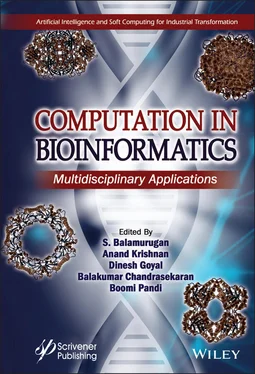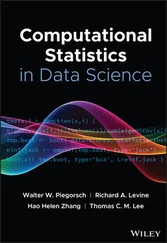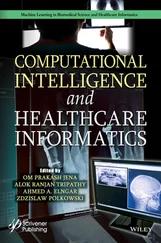Computation in BioInformatics
Здесь есть возможность читать онлайн «Computation in BioInformatics» — ознакомительный отрывок электронной книги совершенно бесплатно, а после прочтения отрывка купить полную версию. В некоторых случаях можно слушать аудио, скачать через торрент в формате fb2 и присутствует краткое содержание. Жанр: unrecognised, на английском языке. Описание произведения, (предисловие) а так же отзывы посетителей доступны на портале библиотеки ЛибКат.
- Название:Computation in BioInformatics
- Автор:
- Жанр:
- Год:неизвестен
- ISBN:нет данных
- Рейтинг книги:4 / 5. Голосов: 1
-
Избранное:Добавить в избранное
- Отзывы:
-
Ваша оценка:
- 80
- 1
- 2
- 3
- 4
- 5
Computation in BioInformatics: краткое содержание, описание и аннотация
Предлагаем к чтению аннотацию, описание, краткое содержание или предисловие (зависит от того, что написал сам автор книги «Computation in BioInformatics»). Если вы не нашли необходимую информацию о книге — напишите в комментариях, мы постараемся отыскать её.
Computation in BioInformatics — читать онлайн ознакомительный отрывок
Ниже представлен текст книги, разбитый по страницам. Система сохранения места последней прочитанной страницы, позволяет с удобством читать онлайн бесплатно книгу «Computation in BioInformatics», без необходимости каждый раз заново искать на чём Вы остановились. Поставьте закладку, и сможете в любой момент перейти на страницу, на которой закончили чтение.
Интервал:
Закладка:
ICM-VLS: ICM Virtual Ligand Screening (VLS) is a combination of internal coordinate docking methodology with a sophisticated global optimization scheme. Its accuracy and fast potentials have led to an efficient virtual screening methodology in which ligands are fully and continuously flexible. It can be accessed at http://www.molsoft.com/vls.html.
1.2.5 Molecular Docking
Molecular docking is a computer simulation methodology which predicts the binding affinity of the target protein with the ligand at the atomistic level. The most important goal of molecular docking studies is to predict the binding conformation of protein-ligand and to estimate its interaction. It is also one of the main tools for virtual screening procedures, where a library of several compounds is “docked” against one drug target returning the best hit. Identifying the active site of the target protein where the ligand will bind is the first important step which needs to be performed before docking. This can be performed using programs like Q-SiteFinder, LigA Site, Meta Pocket, and CASTp [32]. A molecular docking study where the process of docking is performed without predicting the active site is referred as “Blind Docking” [33]. Here, Tables 1.2and 1.3show some of the most common Molecular docking software programs along with their specifications.
AutoDock: It is an automated program to predict ligand and protein (bio-macromolecular targets) interactions. With recent advancement in bimolecular, X-ray crystallography is helping to provide structural information of complex bio-molecules such as protein and nucleic acids. The structures can be taken/downloaded and can be used as targets for new drug molecules in controlling diseases and disorders of human, animal, and plant and understanding of fundamental aspects of biology [41]. It can be downloaded from http://www.scripps.edu/olson/forli/autodock_flex_rings.html(accessed 12.12.16).
GOLD: Genetic Optimization for Ligand Docking is a genetic algorithm which provides docking of flexible ligand and a protein with flexible hydroxyl groups. The software uses a scoring function that is based on favorable conformations found in Cambridge Structural Database. The speed of GOLD and the reliability of its predictions depend on the control of different values of the genetic algorithm parameters. It provides reliable results both protein and ligand ( http://www.ccdc.cam.ac.uk/Solutions/GoldSuite/Pages/GOLD.aspx) (accessed 20.12.16).
Table 1.2 The list of molecular docking softwares is represented in tabular form.
| S. no. | Name of software | Description | Reference |
| 1 | AutoDock | It performs automated docking of flexible ligands to macromolecules. | [34] |
| 2 | DockVision | It performs Monte Carlo, Genetic Algorithm, and database screening docking algorithms. | [35, 36] |
| 3 | GOLD | It helps in identifying correct binding modes of the active target molecules. | [37] |
| 4 | Docking Server | It provides a web-based interface for the molecular docking of protein and ligand. | [38] |
| 5 | SwissDock | It is a protein ligand server that is accessed through ExPASy. | [39] |
| 6 | CombiBUILD | It is a structure-based drug design program which helps in designing of combinatorial libraries. | [37] |
| 7 | QM Polarized Ligand Docking | It performs the function of both Glide and Q-Site applications of Schrodinger Suit. | [40] |
| 8 | Docking Server | It provides a web-based, easy to use interface for the molecular docking of protein and ligand. | [34] |
| 10 | Click2Drug | It is a protein ligand server that is accessed through ExPASy. | http://www.click2drug.org/ |
Table 1.3 The list of molecular docking tools is represented in tabular form.
| Tool | Brief description with uses |
| BLAST | Basic local alignment search tool; used for sequencing of DNA and protein. |
| RasMol | Raster molecule tool; used for molecular visualization of RNA/DNA and protein. |
| Discovery studio | Software; used for modeling and simulation. |
| Pub Med | Free search engine; used for searching matter related to medical and life sciences. |
| PDB | Protein Data Bank; used to collect information related to macromolecule. |
| Chem Draw | They are a part of the Chem office program which are used for drawing chemical molecule. |
| Marvin Sketch | These are advanced chemical editors that are used for drawing chemical structures and reactions. |
| PubChem | Database; used to collect information about structure and physiochemical properties of chemical compound. |
| AutoDock | Software; used for molecular docking. |
1.2.6 QSAR (Quantitative Structure-Activity Relationship)
It is a statistical approach which attempts to correlate relationships between physical and chemical properties of molecules to their biological activities. QSAR predicts the molecular properties from their structure without any need to perform the experiment using in vitro or in vivo . This method saves time and resources [39]. Descriptors which are commonly used are number of rotatable bonds LogP and molecular weight (MW). This approach is used in optimizing lead which is the most important step of discovering drugs. The two techniques in 3D QSAR developed for LBDD are comparative molecular field analysis (CoMFA) and Comparative molecular similarity indices analysis (CoMSIA). Based on the data dimensions many QSAR approaches range from 1D QSAR to 6D QSAR.
a) CoMFA (Comparative Molecular Field Analysis)
It is categorized as 3D QSAR computational technique in which incorporation of experimental activities (log units of KI or IC 50) and the 3D structures of the molecules are done in the study. For this study, a set of derivatives of bioactive compounds having different substitutions is first selected. All of these compounds are then distributed into 30% test set and 70% training set. For QSAR performance, several softwares are available. An important aspect in CoMFA analysis is that it requires a common substructure with good alignment having the same conformation in all molecules.
b) CoMSIA (Comparative Molecular Similarity Indices Analysis)
It is a more advanced method of CoMFA, having fewer limitations. In this approach, SEAL similarity method is used as descriptors. Some of the descriptors used in this method are steric, electrostatic, hydrophobic, and hydrogen bonding. In the ligand binding areas, the unfavored region or the favored regions are indicated by generated contours. Sybyl-X 2.0 and E-Dragon are the software used for QSAR studies.
OCHEM: It is a web-based platform which aims to automate and simplify the typical steps that are required for QSAR modeling. It performs all the steps of a typical modeling workflow and provides facilities to use these data in the modeling process. It can be accessed at https://ochem.eu/home/show.do.
Discovery Studio: This software helps in analyzing the molecular structures/sequences and modeling it. It provides tools for performing analysis of basic data including functionality for editing and viewing data. It is a free viewer which can be used to open data generated by other softwares in the Discovery Studio. It can be downloaded from https://www.3dsbiovia.com/products/collaborative-science/bio-via-discovery-studio/visualization-download.php.
Читать дальшеИнтервал:
Закладка:
Похожие книги на «Computation in BioInformatics»
Представляем Вашему вниманию похожие книги на «Computation in BioInformatics» списком для выбора. Мы отобрали схожую по названию и смыслу литературу в надежде предоставить читателям больше вариантов отыскать новые, интересные, ещё непрочитанные произведения.
Обсуждение, отзывы о книге «Computation in BioInformatics» и просто собственные мнения читателей. Оставьте ваши комментарии, напишите, что Вы думаете о произведении, его смысле или главных героях. Укажите что конкретно понравилось, а что нет, и почему Вы так считаете.












